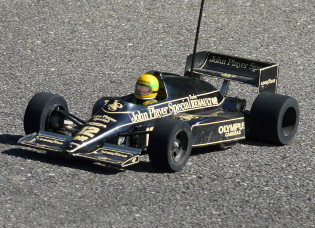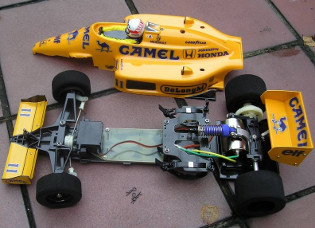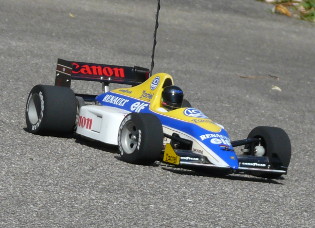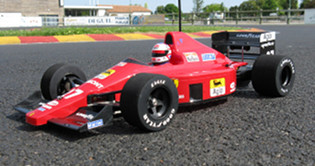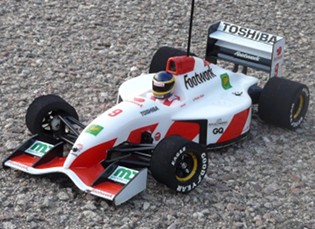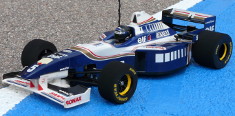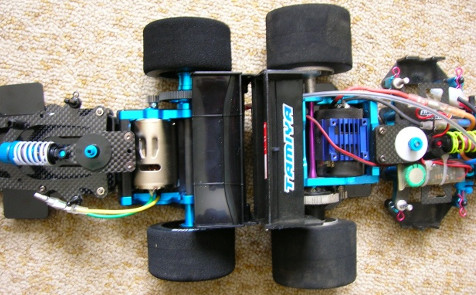Modern Formula 1 platform
This is year 1986 and this is already about a modern chassis. By "modern", I mean that the chassis design will define modern RC racing in Formula 1 up to now. 30 years ago...
In 1986, RC is in its buggy craze. The Road Wizard looks like an attempt, a test to determine whether or not the public still likes this kind of chassis. Reinforcing this guess, this model is mainly based upon two other on-road chassis (kits 58042 and 58052, see below) borrowing most of their front and rear drivetrains. What's more, the Road Wizard is the replica of no real Formula 1 to reduce license costs: as it seems, Tamiya probably made a market test with this model.
58053 Road Wizard F1 (1986)
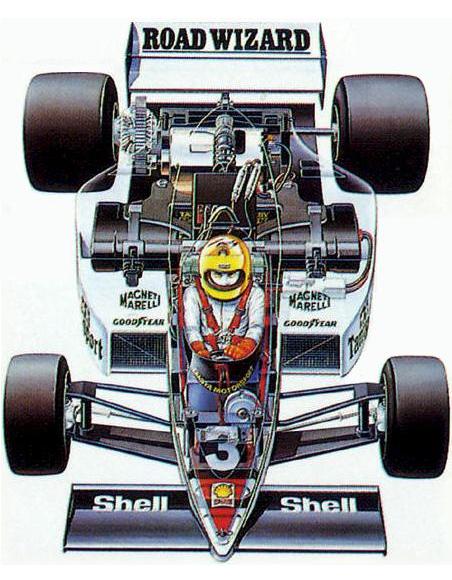
Different possible paint schemes
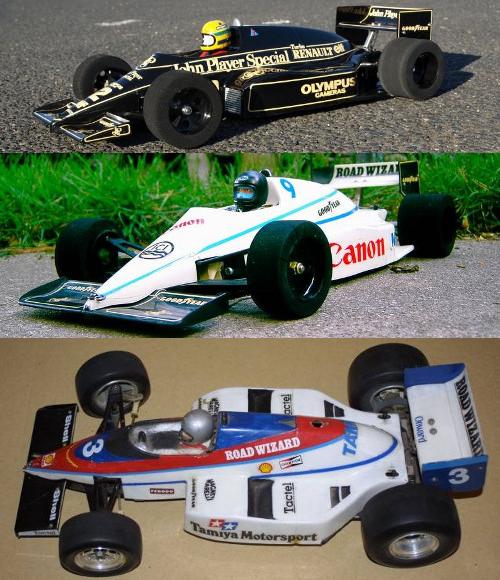
The Road Wizard is Tamiya's first model that comes with two lexan bodies and three different sticker sets. Compared to previous generations, the chassis is even lighter since it uses FRP (Fiberglass-Reinforced Plastic) and features a real suspension with an hydraulic damper instead of relying on the sole chassis flex. The Road Wizard is not the most reliable or solid model ever, but it is very important for Tamiya since it is the true grandfather of all modern Formula 1 chassis.
Two more models will follow in 1987, adding several light improvements to the original Road Wizard chassis design.
Tamiya's market test revealed to be successful despite the RC market still being in the buggy craze. The Road Wizard as a first step, then the two evolutions made Tamiya decide to keep on with the development of the platform: 3 years later, the F101 chassis will be released on the 58084 Ferrari F189 model kit. From then on, the Formula platform will be a continuous success during the 90's and up to now.
Foresee talent or circumstances? I'd vote for the first option since year 1990 marks a radical turn for the RC market: after a true off-road craze during most of the 80's, the public massively goes for on-road vehicles... because of Tamiya. We'll see that when reviewing the DF-01 / TA-01 platforms.
So 1990 is the release of the F101 chassis, a name given afterwards by Tamiya to this chassis: at the time, Tamiya was not used to name their chassis. Yet.
F101 chassis
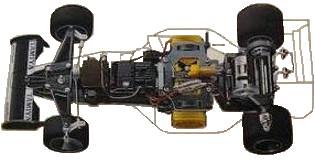
Model overview
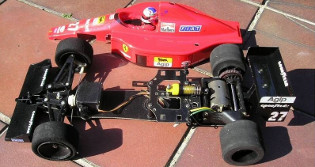
58090 Tyrrell 019 Ford (1990)
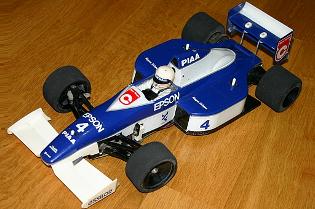
58095 Lotus 102B Judd (1991)
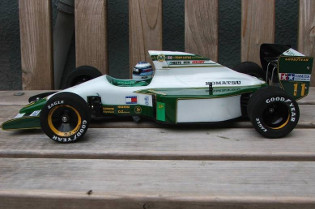
58103 Jordan 191 (1992)
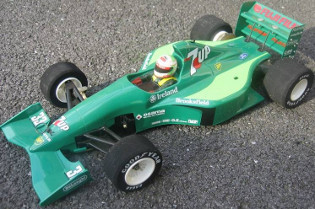
The relationship between the F101 and the Road Wizard chassis is pretty obvious. The F101 features several important improvements among which a ball differential, a more efficient suspension with more travel, and a serious improvement of the overall solidity. It is quite surprising to see the last F101-based model was released just a few months before the new F102 chassis: for their 103rd model, Tamiya may have had problems in obtaining the rights for the body replica. This would explain the delay: the real Jordan 191 ran the 1991 Formula 1 season but its RC replica was only released by the end of 1992.
The F101 chassis lifetime is rather short (apart from the late 58103 Jordan 191 release) and it quickly leaves room to the new F102 chassis in 1992 inaugurated by the 58104 McLaren MP4/6 Honda model kit.
58104 McLaren MP4/6 Honda (1992)
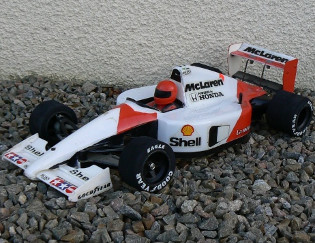
F102 chassis
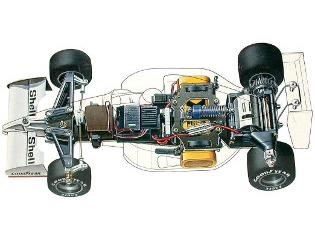
F102 drivetrains
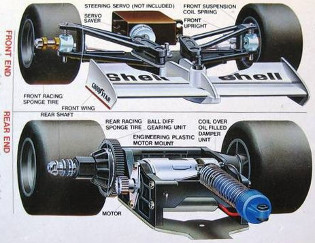
58105 Williams FW14 Renault (1992)
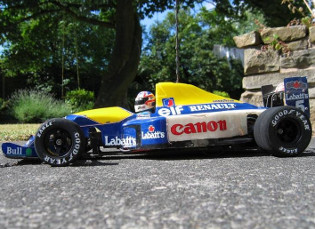
58118 Benetton B192 (1993)
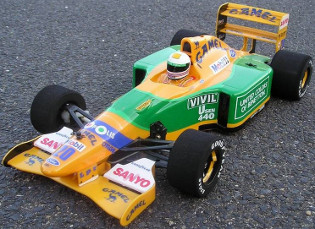
The F102 chassis lifetime was short too, despite its good overall performance, especially the grip on the rear drivetrain for power transmission. The F102 is narrower that its predecessor and introduces several improvements, the most visible being the spoked rims which are more rigid than the F101 dish rims. But the greatest improvement is a much better grip of the front drivetrain.
1993 is the release year of the F103 chassis, the most used in the Formula platform, and the first offering different variants. Undoubtedly, it is Tamiya's best chassis since the beginning of the Formula series. It was even granted a limited series re-released version in 2008 to celebrate its 15th anniversary, showing how much important it is for Tamiya.
58126 Lotus 107B (1993)
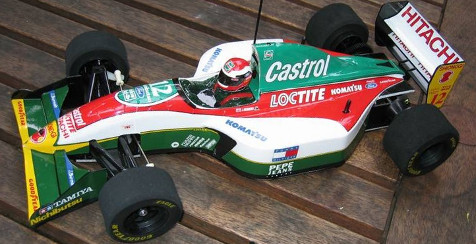
F103 chassis
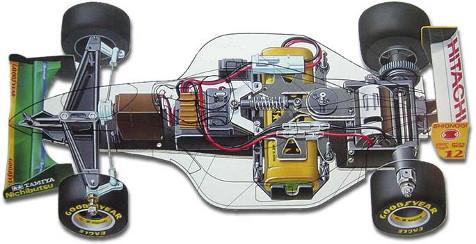
This new generation is a huge overall improvement compared to the F102, including a friction damper plate system reducing chassis roll and a better steering using isometric tie-rods from a vertically mounted steering servo. The F103 chassis performances and overall handling reach higher levels than its predecessor as soon as the pilot is gifted enough. There are different variants of this chassis:
F103L chassis (1994)
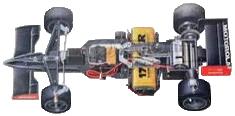
F103RS chassis (1995)
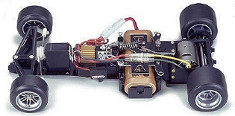
F103LM chassis (1999)
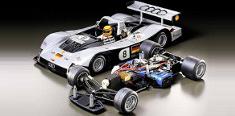
F103GT-DD chassis (2006)
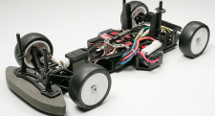
58134 Lola T93/00 Ford
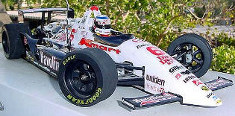
58247 Audi R8R
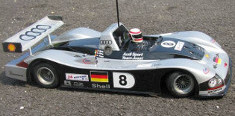
58376 Advance Courage LC70 Mugen
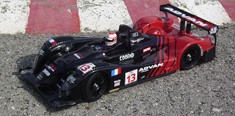
The F103L is a variant with a 20mm longer wheelbase to fit Indy cars bodies, probably to target the US market. The F103RS is an F103 base with weight reduction improving the friction damper plate system to give it more setup tuning options. The F103LM is a unique adaptation to fit the Audi R8R body (LM stands for LeMans series).
The F103GT-DD variant is specific because it was designed as an alternative to DTM chassis. Cheaper, mechanically simpler (so easier to take care off), the F103GT-DD is also much lighter than a classic DTM chassis. Despite having only 2WD compared to DTM 4 WD, its great performance makes it easily compete in this category. The main improvements of this variant are localized on the front drivetrain now featuring front independent arms and at the rear with height adjustment for the gearbox. All this makes the chassis compatible with almost every Touring bodyshell.
Except in club and when rules allowed it, the F103GT-DD chassis was not much used. But when it was, good drivers could seriously compete with the best DTM chassis.
One general note about the F103: it seems that the production of all variants was stopped from 2000 to 2006, presumably because of licensing problems involving the chassis design. Despite finding no proof of that, there is no F103 based model in RC Guide Books editions after 2001.
In 2002, Tamiya released a new version of the Formula platform, a chassis that was very badly understood and accepted by fans for erroneous reasons. And I must confess I only understood this chassis once I finally got one in my hands. The vast majority of fans (among which I was) considered the F201 as the F103 successor. But its 4 wheel drive immediately made the public consider it as an heretic and a fault from Tamiya:
F201 chassis
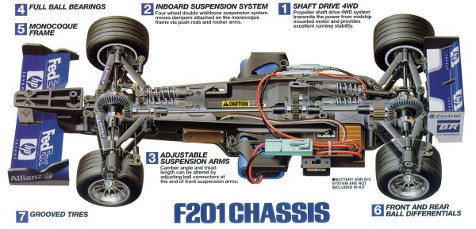
58288 Ferrari F2001 (2002)
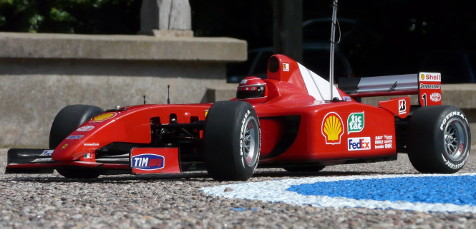
Formula 1 + 4 wheel drive => nonesense! In short and polite, that's how most fans saw the F201.
In fact, Tamiya never designed the F201 to succeed the F103, and never designed it either to be officially raced since F1 category rules, both in real and in RC, only allow 2WD vehicles. However, the “F103 blackout” between 2000 and 2006 certainly didn't help fans understand what the F201 really was.
Indeed, like M. David Jun says, "The suspension is designed on the same principal as full-scale Formula One cars. The double wishbone 4-wheel independent suspension looks and operates just like the real thing right down to the suspension pushrods and rocker arm system (...) While some Formula One purists may object to a 4WD Formula One chassis, others may argue that a 4WD Formula one car is in the realm of possibility more than a live axle, T-plate suspended, coil sprung 2WD car is. Overall, the F201 chassis is the most realistic Formula One chassis Tamiya has ever produced."
58294 F201 Chassis Kit (2002)
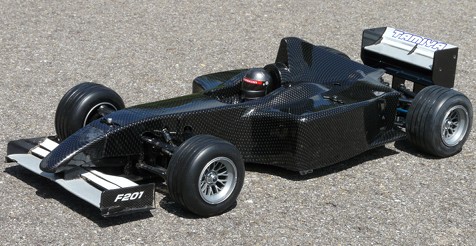
58303 WilliamsF1 BMW FW24 (2003)
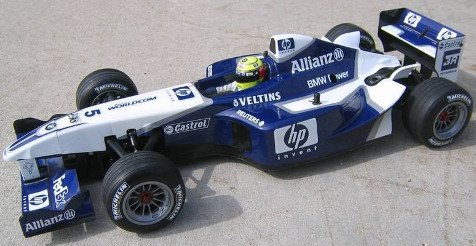
The F201 is an UFO, a chassis I chose to place into the Formula platform review, even though it doesn't really belong to this series. I think the designers at Tamiya made it “because they could”, making it as scale realistic as possible, what you would expect from a manufacturer renowned for the precision and accuracy of their models. In a way, I consider the F201 to share the “spirit” of other models from Tamiya, such as the Tyrrell P34 Six Wheeler and the B2B Racing Sidecar we reviewed previously, or the famous 1986 Porsche 959 we'll see further.
Here is a video of my Ferrari F2001 at the club track:
Despite releasing the F103GT-DD chassis 3 years earlier, Tamiya has been missing a “racing” Formula 1 chassis for about 10 years. That's when Tamiya introduces their new F104 Pro at the 2009 Shizuoka Fair. This time, we are speaking about the successor of the F103.
58431 F104 Pro Chassis Kit (2009)
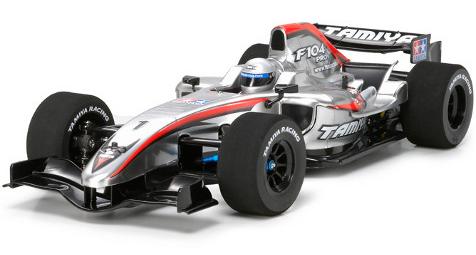
Close up on the F104 Pro chassis
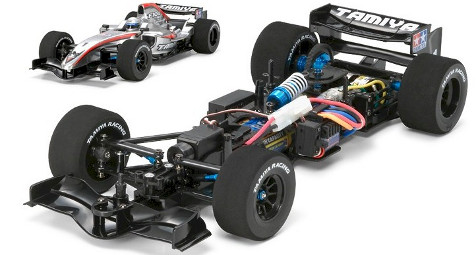
This is a totally new generation with plenty of improvments over the F103:
- a differential housing making easier to change rear wheels
- a longer wheelbase
- narrower drivetrains
- longitudinally mounted stick pack with a better access
- larger rear wheels
- toeing and ground clearance setup easier
- new electronics placement
The new differential housing
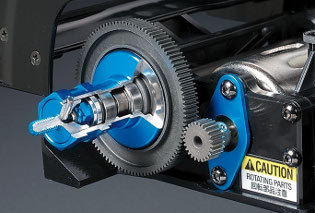
The new front arms
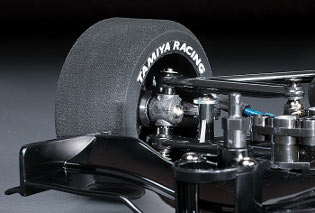
The new stick pack position and access
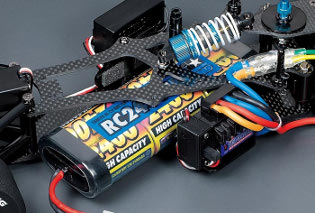
Compared to an F103 chassis hopped-up in the same proportions like the F104 Pro version (meaning carbon and aluminum wherever it is possible), the new generation is about 7 to 8 % lighter (we're talking about 50 to 60 grams on an empty F104 chassis that weights 730 gr).
Here's a direct comparison between an hopped-up F103 (white) and the new F104 Pro (black):
Wheelbase comparison
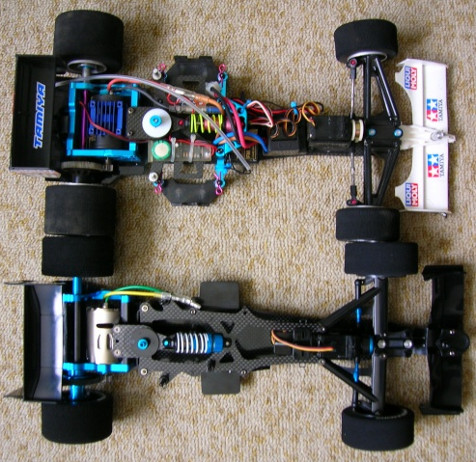
Bottom view of the two chassis
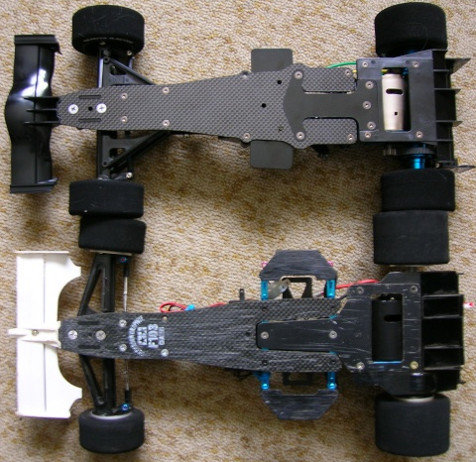
Front track comparison
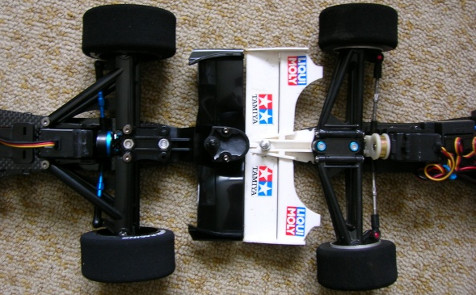
The first fans all agreed considering the chassis was well born, so Tamiya declined it in several models as usual:
58447 Ferrari F60 (2009)
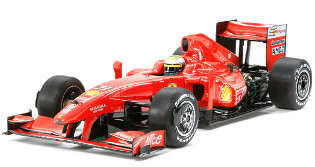
58475 McLaren Mercedes MP4-24 (2010)
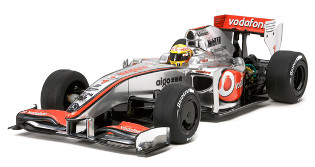
58559 Ferrari F2012 (2012)
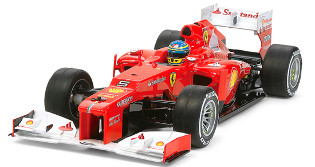
There is also an F104W variant specifically made for the re-release of several F1 bodyshells from the modern F1 platform beginnings. These models were all released in limited series with bodyshells like the Lotus Honda 99T, la 102B Judd etc...
In 2012, Tamiya unveils the F104 version 2. The first version used a friction pad suspension system very similar to the F103's, version 2 introduces a brand new system called "Pillow Ball Link Rear" borrowed to the new RM-01 chassis (we'll see it further).
58534 F104 Pro Version II
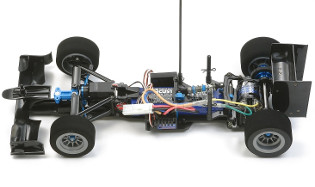
F104 vII Pillow Ball Link Rear
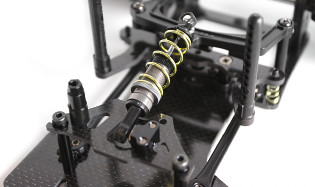
42252 TRF101 (2013)
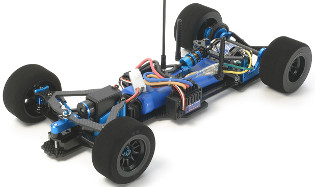
Removing the F104 upper deck saves weight, but it also leaves room for the new suspension system that allows many more setting options for the rear drivetrain (such as chassis roll and pitch). After more than 10 years away from the highest competition levels in F1, the TRF version leaves no doubt about Tamiya's commitment in improving the F104 chassis performance.
Conclusion about modern F1
Even though the Formula platform is not Tamiya's more prolific series of models, it is the oldest one since it started back in 1977 with the Tyrrell P34 Six Wheeler model kit. Another record is the longest lifetime for a single generation (the F103). After about 40 years of evolution, the modern chassis version has nothing in common with its grandfather. This platform also demonstrates all the constraints Tamiya and other manufacturers face:
- market hazards: during the 80's buggy craze, the public show very little interest in Formula series (meeting the decline of the historic 1/12 Pan-Car category)
- even with doubts since the Road Wizard from 1986 looks like a test product, the model is so innovative that it will define the basis of modern RC F1
- licensing: both the increasing costs of rights for reproduction and more generally for design layouts that should not be too close from competitors'
- commercial strategy mistakes: the F201 chassis seen like the F103 successor by the public when it was a totally different concept
The Formula platform left its footprint along Tamiya's RC history, from its debuts when models were true models in motion, to doubts, mistakes and success stories. Commercially or industrially, this is not Tamiya's top most strategic platform, but it is undoubtedly one of the richest.
Related articles:
- 58053 Road Wizard F1
- 58069 Williams FW11B Honda F1
- 58084 Ferrari F189 Late Version - F101
- 58114 Footwork FA13 Mugen Honda - F102
- 58179 Williams Renault FW18 - F103RS
- 58288 Ferrari F2001 - F201




